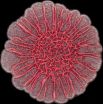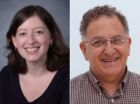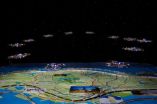(Press-News.org) VIDEO:
The development of colony biofilms by Pseudomonas aeruginosa is affected by redox-active compounds called phenazines. A phenazine-null mutant forms a hyperwrinkled colony with prominent spokes, while wild-type colonies are more...
Click here for more information.
New York, NY—February 10, 2014—In a study published today in Nature Communications, a research team led by Ken Shepard, professor of electrical engineering and biomedical engineering at Columbia Engineering, and Lars Dietrich, assistant professor of biological sciences at Columbia University, has demonstrated that integrated circuit technology, the basis of modern computers and communications devices, can be used for a most unusual application—the study of signaling in bacterial colonies. They have developed a chip based on complementary metal-oxide-semiconductor (CMOS) technology that enables them to electrochemically image the signaling molecules from these colonies spatially and temporally. In effect, they have developed chips that "listen" to bacteria.
"This is an exciting new application for CMOS technology that will provide new insights into how biofilms form," says Shepard. "Disrupting biofilm formation has important implications in public health in reducing infection rates."
The researchers, who include PhD students Dan Bellin (electrical engineering) and Hassan Sakhtah (biology), say that this is the first time integrated circuits have been used for such an application—imaging small molecules electrochemically in a multicellular structure. While optical microscopy techniques remain paramount for studying biological systems (using photons allows for relatively non-invasive interaction to the biological system being studied), they cannot directly detect critical components of physiology, such as primary metabolism and signaling factors.
The team thought there might be a better way to directly detect small molecules through techniques that employ direct transduction to electrons, without using photos as an intermediary. They made an integrated circuit, a chip that, Shepard says, is an "'active' glass slide, a slide that not only forms a solid-support for the bacterial colony but also 'listens' to the bacteria as they talk to each other."
Cells, Dietrich explains, mediate their physiological activities using secreted molecules. The team looked specifically at phenazines, which are secreted metabolites that control gene expression. Their study found that the bacterial colonies produced a phenazine gradient that, they say, is likely to be of physiological significance and contribute to colony morphogenesis.
"This is a big step forward," Dietrich continues. "We describe using this chip to 'listen in' on conversations taking place in biofilms, but we are also proposing to use it to interrupt these conversations and thereby disrupt the biofilm. In addition to the pure science implications of these studies, a potential application of this would be to integrate such chips into medical devices that are common sites of biofilm formation, such as catheters, and then use the chips to limit bacterial colonization."
The next step for the team will be to develop a larger chip that will enable larger colonies to be imaged at higher spatial and temporal resolutions.
"This represents a new and exciting way in which solid-state electronics can be used to study biological systems," Shepard adds. "This is one of the many emerging ways integrated circuit technology is having impact in biotechnology and the life sciences."
INFORMATION:
The study was supported by the National Institutes of Health and the National Science Foundation.
Chips that listen to bacteria
CMOS technology provides new insights into how biofilms form
2014-02-11
ELSE PRESS RELEASES FROM THIS DATE:
Manga comics may help promote fruit consumption among youth
2014-02-11
AUDIO:
May May Leung, Ph.D., R.D., discusses how a recent pilot study in Brooklyn, N.Y., with minority students found that exposure to manga comics (Japanese comic art) promoting fruit intake significantly...
Click here for more information.
PHILADELPHIA, PA, February 10, 2014 – A recent pilot study in Brooklyn, New York, with minority students found that exposure to Manga comics (Japanese comic art) promoting fruit intake significantly improved healthy snack selection. As ...
Political values influence people's response to health disparities messages
2014-02-11
PHILADELPHIA (February 10, 2014) – Policymakers and advocates discussing health disparities in the United States would be wise to consider the political affiliation of their audience, suggests a new study published in the Journal of Health Communication: International Perspectives (2014).
"Understanding Public Resistance to Messages about Health Disparities" was written by Sarah E. Gollust, University of Minnesota School of Public Health; and Joseph N. Cappella, Annenberg School for Communication, University of Pennsylvania. The study examines how political ...
TGen study uncovers possible genetic markers in breast cancer that spreads to the brain
2014-02-11
PHOENIX, Ariz. — Feb. 10, 2014 — The Translational Genomics Research Institute (TGen) has uncovered possible genetic origins of breast cancer that spreads to the brain, according to a first-of-its-kind study published in the scientific journal PLOS ONE.
The compendium of genetic targets uncovered by TGen now can be used to identify potential new methods of diagnosis and new drug therapies for the estimated 45,000 patients in the U.S. each year whose cancer spreads from the breast to the brain.
The 3-year study is significant since these patients currently have few treatments ...
New advance in 3-D printing and tissue engineering technology
2014-02-11
Boston, MA – Researchers at Brigham and Women's Hospital (BWH) and Carnegie Mellon University have introduced a unique micro-robotic technique to assemble the components of complex materials, the foundation of tissue engineering and 3D printing.
Described in the Jan. 28, 2014, issue of Nature Communications, the research was conducted by Savas Tasoglu, PhD, MS, research fellow in the BWH Division of Renal Medicine, and Utkan Demirci, PhD, MS, associate professor of Medicine in the Division of Biomedical Engineering, part of the BWH Department of Medicine, in collaboration ...
Breast cancer drug fights fungal disease
2014-02-11
Tamoxifen, a drug currently used to treat breast cancer, also kills a fungus that causes a deadly brain infection in immunocompromised patients. The findings, which could lead to new treatments for a disease that kills more HIV/AIDS patients than tuberculosis, appear in mBio®, the online open-access journal of the American Society for Microbiology (ASM.)
"This work sets the stage for additional animal studies to see if tamoxifen can be used as a drug in people and will allow us to design new drugs related to tamoxifen that are better antifungals," says Damian Krysan ...
Study shows drop in crime rates is less where Wal-Mart builds
2014-02-10
Communities across the United States experienced an unprecedented decline in crime in the 1990s. But for counties where Wal-Mart built stores, the decline wasn't nearly as dramatic.
"The crime decline was stunted in counties where Wal-Mart expanded in the 1990s," says Scott Wolfe, assistant professor of criminology and criminal justice at the University of South Carolina and lead author of a new study. "If the corporation built a new store, there were 17 additional property crimes and 2 additional violent crimes for every 10,000 persons in a county."
The study, titled ...
Newly found tactics in offense-defense struggle with hepatitis C virus
2014-02-10
The hepatitis C virus (HCV) has a previously unrecognized tactic to outwit antiviral responses and sustain a long-term infection. It also turns out that some people are genetically equipped with a strong countermeasure to the virus' attempt to weaken the attack on it.
The details of these findings suggest potential targets for treating HCV, according to a research team led by Dr. Ram Savan, assistant professor of immunology at the University of Washington. The study was published in Nature Immunology.
HCV infects more than 150 million of the world's people. The ...
NTU showcases expertise in UAV technology at Singapore Airshow 2014
2014-02-10
Nanyang Technological University (NTU) will be showcasing its latest R&D expertise in Unmanned Aerial Vehicle (UAV) technology at the Singapore Airshow, one of the most important aerospace and defence exhibitions in the world, held from 11 to 16 February.
Visitors to the Singapore Airshow will be able to see 12 drones, programmed by NTU scientists and researchers, flying in formation within inches of each other and executing complex indoor aerial manoeuvres.
In addition to the formation air-show by 12 quad-rotor Unmanned Aerial Vehicles complete with strobe lights ...
Australians discover oldest star
2014-02-10
A team led by astronomers at The Australian National University has discovered the oldest known star in the Universe, which formed shortly after the Big Bang 13.7 billion years ago.
The discovery has allowed astronomers for the first time to study the chemistry of the first stars, giving scientists a clearer idea of what the Universe was like in its infancy.
"This is the first time that we've been able to unambiguously say that we've found the chemical fingerprint of a first star," said lead researcher, Dr Stefan Keller of the ANU Research School of Astronomy and Astrophysics.
"This ...
New maps reveal locations of species at risk as climate changes
2014-02-10
An international team of scientists has produced global maps showing how fast and in which direction local climates have shifted.
In research published today in the journal Nature, CSIRO and an international team of scientists revealed global maps showing how fast and in which direction local climates are shifting. This new study points to a simpler way of looking at climatic changes and their likely effects on biodiversity.
As climate change unfolds over the next century, plants and animals will need to adapt or shift locations to track their ideal climate.
"The ...
LAST 30 PRESS RELEASES:
Making lighter work of calculating fluid and heat flow
Normalizing blood sugar can halve heart attack risk
Lowering blood sugar cuts heart attack risk in people with prediabetes
Study links genetic variants to risk of blinding eye disease in premature infants
Non-opioid ‘pain sponge’ therapy halts cartilage degeneration and relieves chronic pain
AI can pick up cultural values by mimicking how kids learn
China’s ecological redlines offer fast track to 30 x 30 global conservation goal
Invisible indoor threats: emerging household contaminants and their growing risks to human health
Adding antibody treatment to chemo boosts outcomes for children with rare cancer
Germline pathogenic variants among women without a history of breast cancer
Tanning beds triple melanoma risk, potentially causing broad DNA damage
Unique bond identified as key to viral infection speed
Indoor tanning makes youthful skin much older on a genetic level
Mouse model sheds new light on the causes and potential solutions to human GI problems linked to muscular dystrophy
The Journal of Nuclear Medicine ahead-of-print tip sheet: December 12, 2025
Smarter tools for peering into the microscopic world
Applications open for funding to conduct research in the Kinsey Institute archives
Global measure underestimates the severity of food insecurity
Child survivors of critical illness are missing out on timely follow up care
Risk-based vs annual breast cancer screening / the WISDOM randomized clinical trial
University of Toronto launches Electric Vehicle Innovation Ontario to accelerate advanced EV technologies and build Canada’s innovation advantage
Early relapse predicts poor outcomes in aggressive blood cancer
American College of Lifestyle Medicine applauds two CMS models aligned with lifestyle medicine practice and reimbursement
Clinical trial finds cannabis use not a barrier to quitting nicotine vaping
Supplemental nutrition assistance program policies and food insecurity
Switching immune cells to “night mode” could limit damage after a heart attack, study suggests
URI-based Global RIghts Project report spotlights continued troubling trends in worldwide inhumane treatment
Neutrophils are less aggressive at night, explaining why nighttime heart attacks cause less damage than daytime events
Menopausal hormone therapy may not pose breast cancer risk for women with BRCA mutations
Mobile health tool may improve quality of life for adolescent and young adult breast cancer survivors
[Press-News.org] Chips that listen to bacteriaCMOS technology provides new insights into how biofilms form





